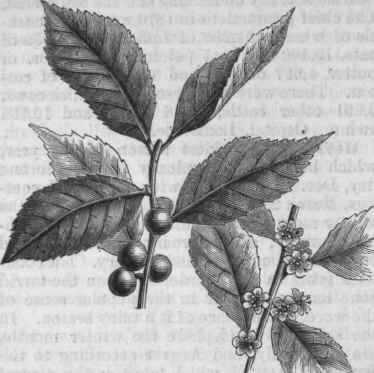Winterberry
Description
This section is from "The American Cyclopaedia", by George Ripley And Charles A. Dana. Also available from Amazon: The New American Cyclopędia. 16 volumes complete..
Winterberry
Several native deciduous shrubs, with fruit and flowers much like those of the holly, were formerly placed in the genus prinos (the Greek name for the holly); but later botanists make them only a subgenus of the holly (ilex), from which they differ mainly in their deciduous leaves and smooth nutlets. The most common and conspicuous winterberry (ilex verticillata) is also called black alder. It is usually 5 or 6, rarely 10 or 12 ft. high, with oval, obovate, or wedge-lanceolate serrate leaves, downy below, but they are not (nor are the flowers) whorled, as the specific name would imply; the flowers are mostly dioecious, the staminate in small axillary clusters four- to six-parted, the pistillate solitary, often five- to nine-parted, and succeeded by a solitary bright scarlet berry the size of a large pea. This is common on the edges of moist grounds, where its brilliant berries in autumn and early winter make it very conspicuous; the color of the fruit is remarkably intense, and where the shrub grows, as it sometimes does, in large patches, it makes a blaze of scarlet unequalled in our winter landscape. It is cultivated in Europe, but rarely in this country. The bark and berries are bitter, and are used as a domestic tonic.
The smooth winterberry (I. laevigata), common near the coast from Maine to Virginia, has smoother and narrower leaves, the sterile flowers on a long peduncle, and larger, less brilliant berries, which ripen earlier than the preceding. There are a few other related species, some with purple fruit; but these are much less common.

Winterberry (Ilex verticillata).
Continue to:


